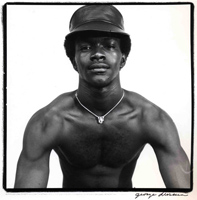George Dureau’s Black, at Higher Pictures through July 13 is a jewel of an exhibition comprised of only 15 black-and-white prints. Though the artist is in his eighties, and though the photos on view are from the ’70s and ’80s, for many of us, this small show serves as an introduction to Dureau’s work.
Dureau’s most frequent subject is the male body, and his sitters were fellow New Orleanians—friends, neighbors and lovers. Several of these men had the bodies of athletes, some were missing limbs, at least one was a dwarf. Dureau is a master at seeing and rendering the beauty and sensuality of his subjects, regardless of imperfection. While they reflect the adoration and desire of the photographer, the photographs also reflect a sense of self-possession in the subjects, and a true sense of communion with the photographer.
The title that Higher Pictures’ Kim Bourus gave the show makes reference to Robert Mapplethorpe’s Black Book, published in 1986, which inevitably comes to mind when regarding these erotically charged portraits. Though there are varying accounts of their acquaintance, and the degree to which Mapplethorpe may have appropriated some of Dureau’s photographic gestures, it is fact that the two knew each other, and that Mapplethorpe was a fan of Dureau’s portraits, which were shown in New York only once before, in 1981 at Robert Samuel Gallery.
Dureau is a fixture in New Orleans, and known as much for his drawings and paintings of male nudes, which comprise the majority of his oeuvre, and which are always rendered in a classical style, as for his photographs. His photographs have often been described as having a “cult” following, but in point of fact, that following has been primarily gay. Dureau’s only book, New Orleans: 50 Photographs, was published in 1985 by Gay Men’s Press in London. Whatever the admiration or notoriety these photos garnered, up till now it seems they only embraced in terms of identity politics of the ’70s and ’80s—of gay rights, and black power. But these portraits deserve a wider audience. Their unquestionable homoeroticism, like that in the work of Mapplethorpe, is hardly their only value.

